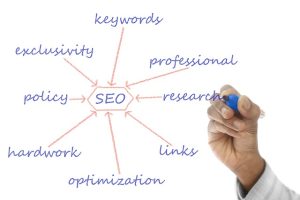SEO Content Optimization is a dynamic process that enhances online visibility and ranking on search engines like Google. It involves understanding search algorithms, keyword research using tools like Google Keyword Planner, SEMrush, or Ahrefs, and audience analysis to create resonant content. On-page optimization includes strategic keyword placement, content structuring with header tags, and readability enhancements. Regular content refreshes with updates, new data, trends, and improved visual elements maintain authority. Meta tags and titles boost search visibility and attract organic traffic, while building high-quality backlinks enhances website authority. Measuring results using tools like Google Analytics guides strategy adjustments. Future-proofing includes focusing on voice search optimization, leveraging AI-powered tools, and personalizing content for maximum impact.
“Unleash your content’s full potential with our comprehensive guide to SEO Content Optimization. In today’s digital landscape, understanding SEO is pivotal for online success. This course delves into essential strategies, from keyword optimization and audience analysis to effective on-page techniques and content refresh strategies. Learn how to enhance search visibility using meta tags and titles, build high-quality backlinks, and track results with powerful analytics tools. Discover the future of SEO Content Optimization and elevate your digital presence.”
Understanding SEO Content Optimization: A Brief Overview

SEO Content Optimization is the process of enhancing online content to improve its visibility and ranking on search engines like Google. It involves a deep understanding of how search algorithms work, coupled with strategic adjustments to content structure, keyword usage, meta tags, and other factors that influence search results. By optimizing content, businesses can increase organic traffic, boost brand awareness, and ultimately drive conversions.
A key aspect of SEO Content Optimization is staying abreast of the latest trends and updates in search engine algorithms. Search engines constantly evolve their criteria for ranking websites, with regular algorithm changes designed to reward high-quality, relevant, and engaging content. Therefore, a successful SEO strategy requires continuous learning, adaptation, and refinement to keep pace with these shifts and maintain or improve search rankings over time.
Identifying Key Targets: Keywords and Audience Analysis

Identifying your key targets is a crucial step in any SEO Content Refresh course. It begins with thorough keyword research, where you unearth the phrases and terms that your target audience uses when searching for information related to your niche. Tools like Google Keyword Planner, SEMrush, or Ahrefs can help uncover these keywords, revealing their search volume and competition levels. This process ensures your content is optimized for both relevance and discoverability.
Once keywords are identified, an in-depth audience analysis follows. Understanding who your ideal readers are, their needs, preferences, and pain points, enables you to create content that truly resonates with them. Demographic data, user behavior patterns, and feedback from existing customers can all provide valuable insights. By combining keyword research and audience analysis, you set the foundation for effective SEO Content Optimization, ensuring your refreshed content not only ranks higher but also connects meaningfully with your intended audience.
On-Page Optimization Techniques for Maximum Impact

Optimizing your content for on-page SEO is a strategic approach that involves several techniques to enhance search engine rankings and user engagement. It begins with thorough keyword research, where you identify relevant keywords and phrases that accurately describe your content. These keywords are then seamlessly integrated into your titles, headings, meta descriptions, and throughout the body of your text. This process ensures that both search engines and users understand the topic and context of your content.
Additionally, on-page optimization includes refining your content’s structure and readability. Creating a logical hierarchy through header tags (H1, H2, etc.) organizes your content, making it easier for readers to scan and for search algorithms to interpret. Enhancing readability with concise paragraphs, subheadings, and bullet points not only improves the user experience but also signals to search engines that your content is valuable and well-crafted.
Content Refresh Strategies: Making Your Old Content New Again

Content Refresh Strategies are essential techniques in the ever-evolving world of SEO Content Optimization. Revitalizing old content can be a powerful way to maintain and even boost your search engine rankings. One effective approach is updating and republishing existing content with fresh, relevant information. This involves adding new data, statistics, or industry trends that weren’t available when the original piece was written. By doing so, you not only provide value to your readers but also signal to search engines that your content is current and authoritative.
Another strategy is restructuring the content by reorganizing paragraphs, improving readability with subheadings, and enhancing visual appeal through updated media elements. Changing keywords or adding new ones can also improve content discoverability. Additionally, incorporating user-generated content, such as quotes or reviews, can add authenticity and encourage engagement, further boosting your SEO efforts. These strategies collectively contribute to the longevity of your content, ensuring it remains valuable and engaging for both search engines and readers alike.
Utilizing Meta Tags and Titles for Better Search Visibility

In the realm of SEO Content Optimization, meta tags and titles play a pivotal role in enhancing search visibility. These elements are the first point of contact between your content and potential visitors, making them crucial for attracting organic traffic. Meta tags, hidden within the HTML code, offer a concise summary of your page’s content, providing search engines with vital context to index and rank your pages accurately. Crafting effective meta tags involves balancing keyword relevance with compelling language, ensuring they not only inform but also entice users to click.
Titles, on the other hand, are the visible headings that appear in search results, subject to character limits. Optimizing titles by incorporating relevant keywords naturally can significantly boost your page’s ranking. The title should accurately reflect the content while maintaining a user-friendly tone and structure. By harmoniously integrating these meta elements, you empower search engines to better understand your content’s purpose, thereby increasing the likelihood of it appearing in targeted searches, ultimately driving more qualified visitors to your site.
Building Quality Backlinks: A Vital Component of SEO

In the realm of SEO Content Optimization, building quality backlinks stands as a cornerstone strategy. These links, earned from reputable sources, act as digital endorsements, enhancing your website’s authority and visibility in search engine results pages (SERPs). When high-quality websites link to yours, it signals to search engines that your content is valuable and trustworthy, prompting them to rank your site higher for relevant keywords. This organic growth not only drives more traffic but also fosters a sense of community within the digital landscape.
Effective backlink building involves a strategic approach. It requires identifying industry influencers and relevant websites, creating compelling content that naturally attracts links, and engaging in outreach to secure these valuable connections. By focusing on quality over quantity, you ensure that each backlink contributes significantly to your SEO efforts. This strategy aligns with search engine algorithms designed to promote the most relevant and beneficial resources, making it a vital component of any comprehensive SEO Content Refresh Course.
Measuring and Analyzing Results: Tools for Tracking Progress

Measuring and analyzing results is a crucial step in any SEO content optimization strategy. It allows content creators and marketers to understand what’s working, what needs improvement, and ultimately, how their efforts are impacting search engine rankings. Several powerful tools can aid in this process, providing detailed insights into website performance and user behavior.
From Google Analytics to specialized SEO platforms, these tools offer a wealth of data on keyword rankings, organic traffic, bounce rates, and more. By regularly reviewing these metrics, content refreshers can identify low-performing pages, pinpoint areas where SEO strategies need adjustment, and make data-driven decisions to enhance overall online visibility.
Future Trends in SEO Content Optimization

As we move into a future driven by rapid technological advancements, several trends are shaping the landscape of SEO content optimization. One prominent trend is the increased emphasis on voice search and natural language processing (NLP). With more users relying on voice assistants, optimizing content to answer conversational queries will be key. This shift requires a focus on long-tail keywords and creating content that mirrors human dialogue.
Additionally, artificial intelligence (AI) is playing a growing role in SEO. AI-powered tools can analyze vast amounts of data to identify trends, suggest relevant topics, and even generate content outlines. Personalization is another critical aspect; leveraging user data to deliver tailored content experiences will enhance engagement and improve search rankings.
